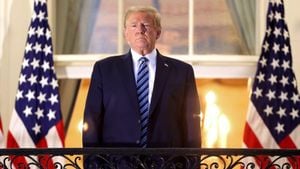The much-anticipated moment has arrived: the United States has returned over 1,440 looted artifacts to India, collectively valued at around $10 million. This substantial repatriation marks another chapter in the long-standing effort to recover stolen cultural items, particularly those pillaged from South Asia.
Among the notable pieces returned is the Celestial Dancer, a sandstone sculpture dating back to the 11th century, which was dislodged from its place at a temple located in Madhya Pradesh during the 1980s. The piece and its history encapsulate not just the artistic heritage of India, but also the grim realities of art trafficking.
The intricacies of how this sculpture was smuggled are particularly vivid. After being illegally taken from India, it was smuggled to London, where art traffickers cleaved the statue to facilitate its transit. By February of 1992, it made its way to New York, where it was professionally reassembled and eventually found its way to the Metropolitan Museum of Art. It graced the museum’s exhibits until seized by authorities during investigations last year. The return of this piece has been hailed both for its historical significance and its role as a poignant reminder of the lengths to which traffickers will go.
The repatriation effort was part of broader international investigations targeting complex smuggling operations. It was particularly tied to the cases of notorious art dealers like Subhash Kapoor, whose activities have been described as some of the most prolific archaic looting operations. Kapoor, currently held on multiple counts of theft and smuggling, is considered one of the central figures responsible for trafficking thousands of artifacts out of India.
Other significant returned pieces included the Tanesar Mother Goddess, which was also stolen from its original site—specifically, the village of Tanesara-Mahadeva, Rajasthan—in the 1960s. This specific artifact reflects the rich culture and history of Indian sculpture, as it was first documented by archaeologists in the late 1950s, illustrating the long history of theft these items have endured.
The Manhattan District Attorney’s office has been actively pursuing the recovery of these artifacts, and they emphasized their commitment to investigating the extensive trafficking networks targeting cultural heritage. Manhattan District Attorney Alvin L. Bragg, Jr., made it clear, affirming the office's determination to combat the criminal enterprises exploiting these treasures.
“Today’s repatriation marks another victory in what has been a multi-year, international investigation,” Bragg stated. "We will continue to investigate the many trafficking networks targeting Indian cultural heritage.”
This latest repatriation is not the first; since 2016, more than 578 artifacts have been returned from the U.S. to India—the highest number returned from any nation, reflecting growing cooperation between the two countries. Even within this broader framework of repatriation, the returned items take on monumental significance. They span periods from 2000 BCE to 1900 CE and reflect diverse regions across India, including items not only from central and eastern parts but also from various other regions.
A formal ceremony marking this significant handover took place at the Indian Consulate General, where representatives from both nations gathered to celebrate this momentous occasion. This gathering underscored the cultural ties and mutual commitments between India and the United States to recover items reflecting their shared heritage.
The U.S. has also been increasingly proactive about preventing illegal trafficking of cultural property. Just earlier this year, both nations formalized their commitment through the Cultural Property Agreement, which was established explicitly to halt the illegal flow of antiquities and to bolster cooperative efforts linked to returning stolen cultural property.
William S. Walker, Special Agent in Charge of Homeland Security Investigations, reiterated the collaborative spirit present during the investigations. He emphasized the need to dismantle persistent networks of illegal trafficking, noting, “We remain resolute in our commitment to safeguard against the plundering of antiquities and guarantee full accountability for those who seek to profit from these heinous acts.”
This focus on international cooperation in dismantling trafficking operations highlights not only the seriousness of this issue but also the commitment to protecting cultural heritage.
India triumphs with this significant return, seeing it as much more than just the re-acquisition of physical objects. Prime Minister Narendra Modi, during previous discussions on this topic, has articulated the broader importance of these artifacts, stating they form the core of India's historical narrative and facilitate connections to its cultural consciousness.
The return of the Celestial Dancer and surrounding artifacts serves as all the more pressing as numerous items remain outside India's borders, with many more expected to be repatriated. The road remains long, but these returns symbolize hope for many advocates of cultural policies, providing encouragement for future reclamation efforts. More than merely returning physical artifacts, this collaborative endeavor fosters relationships between nations and emphasizes the importance of cultural heritage across the world.
With the increased focus on cultural preservation and restoration through legal frameworks and international dialogue, the message is clear: looted antiquities are just as much part of their countries of origin as the land they come from. Efforts to see these items returned continue, and as shown, each victory adds to the broader narrative of respect for cultural heritage.
The art community and advocacy groups will be keeping their eyes on developments, eagerly awaiting information about upcoming repatriations, and celebrating today’s success as another step toward justice for cultural heritage. The collaborative efforts between the U.S. and India will undoubtedly pave the way for continued progress, allowing history to be restored alongside the art itself, bringing with it stories of the rich history these objects represent.



